



Blueprint for Top Gilt Performance
Focusing on indoor gilt management has brought benefits on one farm, reported by BPEX as Farm Case Study No. 27.Background
Ian Smith, unit manager, purchases gilts as a split group of four age groups (12, 16, 20 and 22 weeks); they are delivered to an off-site isolation building. Gilts are vaccinated according to the unit herd health plan and after eight weeks, and clearance from a ‘vet-to-vet’ with the breeding company, they are moved to the main unit in their original groups. A V-boar is introduced immediately on arrival and on a daily basis from then on; after the initial observation of heats, he is left in the pen for at least one hour. The boar is then removed and housed away from the gilts until being re-introduced the next day.
| * "Allocating sufficient time to managing the gilts and preparing them for a lifetime’s top performance is time well spent." |
|
Ian Smith, Unit Manager
|
The System
- All heats are recorded and colour-coded by week, providing a visual record of when gilts are cycling
- The aim is to serve on the second or third observed heat, at about 150kg liveweight and body condition score 4
- Gilts are moved to the service area five days before their planned service week and given fenceline boar contact during the day
- They are fed a lactation diet ad lib until the end of the service week, when they are fed 2.25kg of dry sow ration
- Gilts are served with 100 per cent DIY AI as soon as they show a standing reflex
- They are inseminated either am-pm-am or pm-am-pm and post-AI, they are given another 30 minutes of fenceline boar contact before returning to their pens; they remain in these groups for four weeks
- Gilts are scanned and if positive, they are mixed in with the rest of the service week to make groups of 24.
Benefits
- First parity performance on a par with the herd average
- High retention rate and so reduced replacement rate
- Controlled parity profile with high number of voluntary culls
- It is a way of managing gilts without Regumate, saving time and money.
| Agrosoft Ltd. | Gilt parity | Herd average |
|---|---|---|
| Farrowing rate % | 93.4 | 92.3 |
| Total born/litter | 12.4 | 13.1 |
| Total weaned per litter | 11.9 | 11.4 |
| Pigs weaned per sow per year | 28.6 | 26.3 |
Keys to Success
- Having a well-run, off-site isolation unit away from the main herd
- Carrying out a vet-to-vet check to make sure there has not been a breakdown in health at the breeding unit
- Recording all heats with a colour-coding system
- Ensuring gilts are in the target body condition for breeding
- Keeping stress to a minimum by keeping gilts in stable groups until confirmed in-pig.






